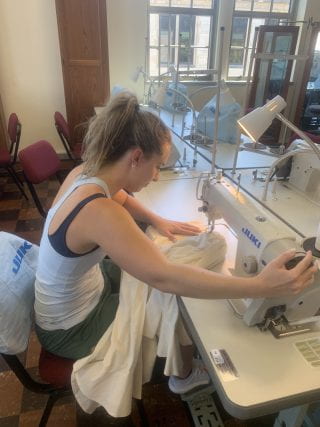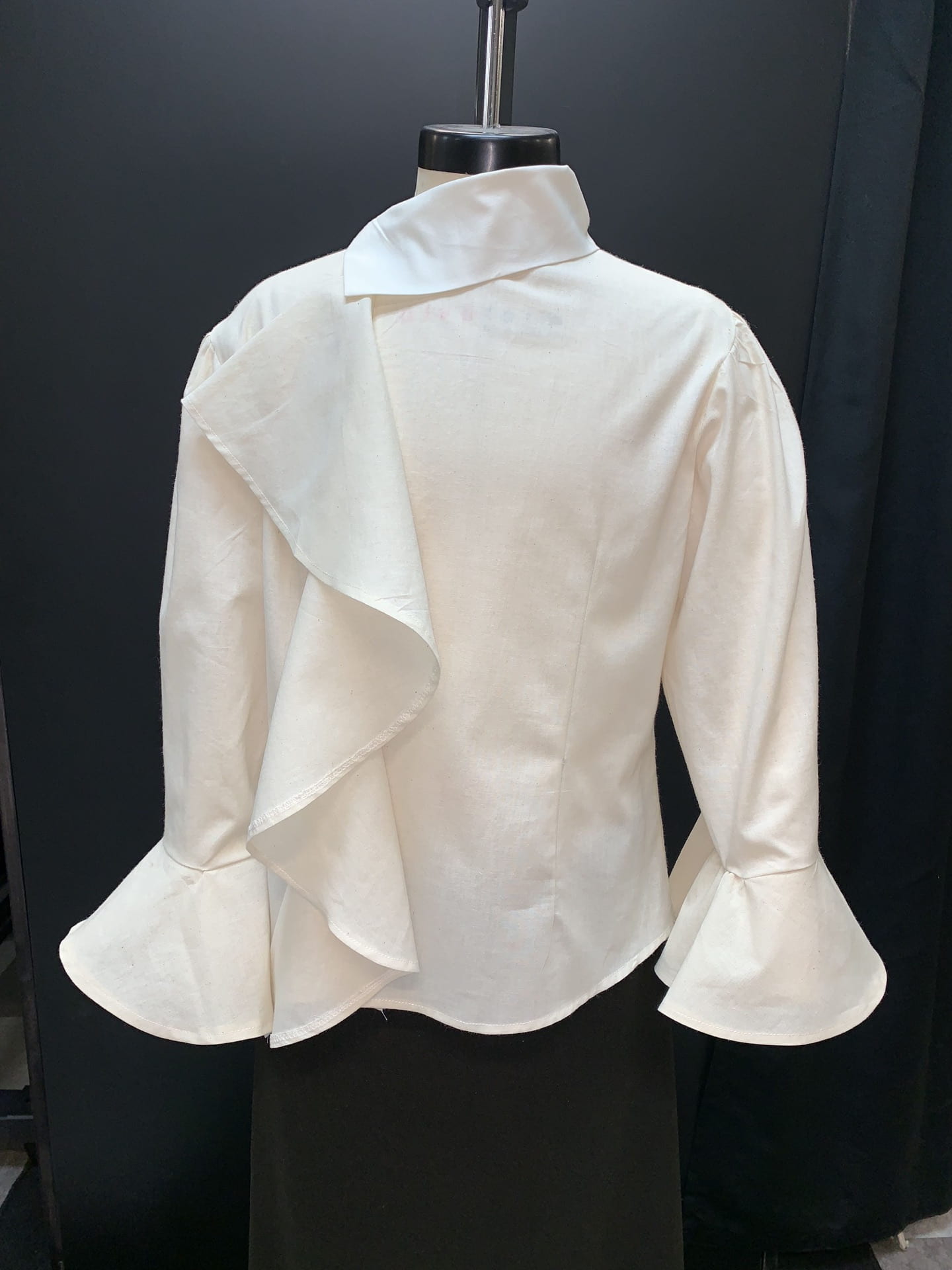Honors apparel merchandising and product development major Hannah Lane is using her honors thesis to create fashion pieces for an oft-overlooked group: breast cancer survivors who have undergone double mastectomies and opted against reconstruction. Creating the prototype for the dress shirt proved to be an arduous task full of trial and error, but Hannah could not be more excited about what she learned from the process and where it will take her this year.
During the summer of 2019, and continuing this fall semester, I performed research in the Apparel Merchandising and Product Development Department, under the guidance and supervision of my mentor, Dr. Laurie Apple. The purpose of my research and strategy of execution is to develop professional dress shirts for women who are post double-mastectomy and have chosen not to undergo reconstruction. A mastectomy is a surgical procedure that results in the removal of all or part of a woman’s breast tissue in order to effectively treat breast cancer. In order to create these garments, Dr. Apple and I used a previously developed one-dart bust block; although the bust sloper was developed by a former honors graduate, it had never been used before this project.
My research on this topic began early in the spring 2019 semester, though I began the physical process of constructing the garment in the early weeks of the summer semester. I spent many hours in the sewing lab constructing our first prototype of an asymmetrical, button-down garment, complete with a singular ruffle on the button closure, ruffled cuffs, and a fold-over collar; the entire prototype garment was constructed out of 100% muslin. This garment was also submitted to the International Textile and Apparel Association (ITAA) as a creative design, for the opportunity to attend the ITAA conference in October 2019 in Las Vegas, Nevada.
 The construction process of the prototype was a long and strenuous one; very rarely did I get it right on the first attempt, and even less often without the guidance of Dr. Apple. The drafting process did not present many problems, but during construction we were challenged with fit issues mainly in the sleeves and bodice. The initial draft of the sleeves was altogether too large, and this resulted in the inset-sleeve being extremely wide and too long. In an attempt to correct this, the sleeve was then gathered at the shoulder, the width taken in approximately 3 inches, and length taken up approximately 4 inches. For the bodice, the drafts are based on measurements given to us by a volunteer who has undergone a double mastectomy and decided against reconstruction. We constructed the bodice of the prototype according to these measurements, although the end result is that the fit of the bodice was too tight in the abdomen and chest area and will need to be wider in both areas on the final construction. The original pattern drafts will also have to be modified in order to reflect these changes.
The construction process of the prototype was a long and strenuous one; very rarely did I get it right on the first attempt, and even less often without the guidance of Dr. Apple. The drafting process did not present many problems, but during construction we were challenged with fit issues mainly in the sleeves and bodice. The initial draft of the sleeves was altogether too large, and this resulted in the inset-sleeve being extremely wide and too long. In an attempt to correct this, the sleeve was then gathered at the shoulder, the width taken in approximately 3 inches, and length taken up approximately 4 inches. For the bodice, the drafts are based on measurements given to us by a volunteer who has undergone a double mastectomy and decided against reconstruction. We constructed the bodice of the prototype according to these measurements, although the end result is that the fit of the bodice was too tight in the abdomen and chest area and will need to be wider in both areas on the final construction. The original pattern drafts will also have to be modified in order to reflect these changes.
Though it may seem like there were more negative experiences than positive ones, this was not the case. Our final prototype garment turned out beautifully, and Dr. Apple and I genuinely enjoyed the entire creative process. Furthermore, my time spent in the sewing lab was also a great refresher course for me on general construction information that I had learned semesters earlier but hadn’t executed in a long time. During this process, what I’ve learned about myself is that I truly enjoy sewing and designing garments, especially when they have a significant purpose. With that being said, I probably will not become a designer as my career, but I have realized that I enjoy having creative freedom and working with my hands.
 Dr. Apple has been my right-hand man during this process. She has given me the responsibility of designing and constructing the garments and making all the decisions, but has not left me without guidance. She always made herself available to me whenever I had questions or needed to work in the lab; through this partnership, I have developed the same passion for this project that Dr. Apple herself has.
Dr. Apple has been my right-hand man during this process. She has given me the responsibility of designing and constructing the garments and making all the decisions, but has not left me without guidance. She always made herself available to me whenever I had questions or needed to work in the lab; through this partnership, I have developed the same passion for this project that Dr. Apple herself has.
In order to continue our work, we will begin constructing the final prototype of the asymmetric button-down garment, constructed out of a solid white Poplin fabric, this fall. Dr. Apple and I have also previously discussed designing and assembling a second dress shirt, but that is dependent on time constraints and willingness to complete a second design. As I mentioned previously, I submitted the design and a proposal to the International Textile and Apparel Association for the opportunity to attend the conference in October. As of now, we are awaiting acceptance from ITAA.

